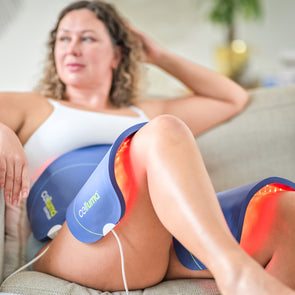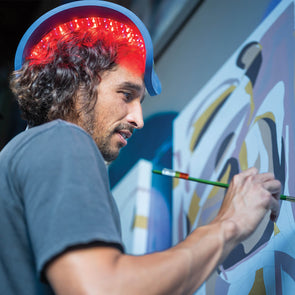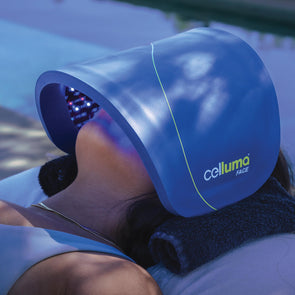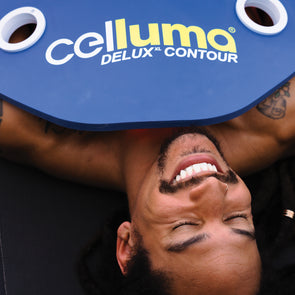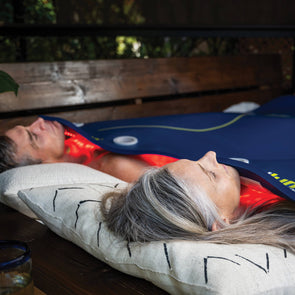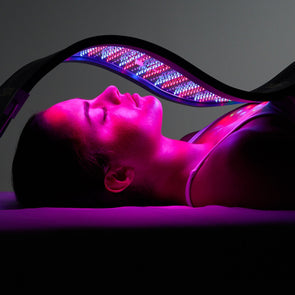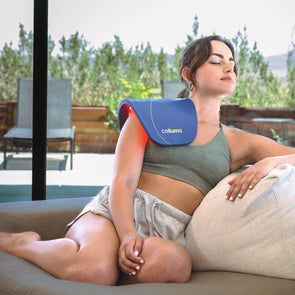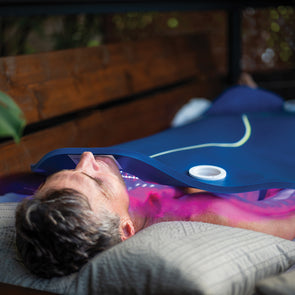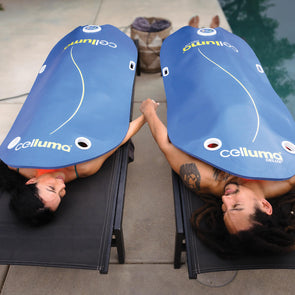Letting the Light In: The Basics of LED Red Light Therapy and Arthritis Pain

Whether from personal experience or from watching someone you love struggle to do things that used to come so easily, the damage arthritis can cause is well known, if not understood. An often-silent intruder, arthritis can seemingly infiltrate lives out of nowhere, diminishing mobility and stealing the joy of living life to the fullest.
Arthritis is a prevalent condition impacting millions worldwide. And it’s not just a single disease but an umbrella term for several types, each casting its own shadow of pain and limitations. According to the Arthritis Foundation, approximately 54 million adults in the United States alone suffer from this chronic condition, and the numbers continue to rise.
Types of arthritis
Most people don’t realize there are more than 100 different forms of arthritis diseases. The most common forms of arthritis are osteoarthritis (OA), rheumatoid arthritis (RA), psoriatic arthritis (PsA), fibromyalgia and gout.
The Mayo Clinic defines arthritis this way: “Arthritis is the swelling and tenderness of one or more of your joints. The main symptoms of arthritis are joint pain and stiffness, which typically worsen with age.
The most common types of arthritis are osteoarthritis and rheumatoid arthritis. Osteoarthritis causes cartilage — the hard, slippery tissue that covers the ends of bones where they form a joint — to break down. Rheumatoid arthritis is a disease in which the immune system attacks the joints, beginning with the lining of joints.”
Symptoms of both osteoarthritis and rheumatoid arthritis can include pain, inflammation, stiffness, redness, and decreased range of motion. Those suffering might notice a tightness or redness of the skin around the effected joints. And both forms of arthritis cause damage in different ways.
For those of us living with arthritis, we know it can have a major impact on quality of life.

Arthritis treatment options
Traditional treatment options for arthritis range from over-the-counter pain relievers to lifestyle changes to physical therapy to surgical options such as joint repair, replacement, or fusion.
But we know there is an even better way to treat arthritis that is non-toxic, non-invasive, and non-pharmacologic. And it's LED red light therapy.
How does red light therapy help treat arthritis pain?
If you have ever suffered from the effects of either osteoarthritis or rheumatoid arthritis, then you know the pain and discomfort this disease can cause. But there is a non-invasive, non-pharmaceutical alternative to treating arthritic pain that goes beyond medication and ointment you rub on your skin: LED red and infrared light therapy.
Red light therapy, also known as low-level light therapy (LLLT), operates on the principle of phototherapy, where specific wavelengths of light penetrate the skin to stimulate cellular activity. This gentle, yet effective therapy targets inflammation and pain at the source, fostering tissue repair and reducing discomfort. For arthritis sufferers, it’s a glimmer of hope in the shadows of discomfort, providing a safe and drug-free alternative to managing symptoms.
Perhaps an easier way to picture it is this: just like plants getting their energy from the sun during photosynthesis, red light therapy uses specific, proven wavelengths of light energy to stimulate a natural response in human tissue that can increase circulation, accelerate tissue repair, ease muscle pain, relieve joint stiffness, and enhance overall cell performance on a microscopic level.
How often should you use red light therapy for arthritis?
Red light therapy can help to reduce inflammation and bring much needed pain relief. However, treatments for chronic pain can vary with wide ranging results depending on the severity of the condition being treated. Some people find relief from 30 minutes daily or more, while others may use it just 2-3 times per week and see results.

How does red light therapy get rid of inflammation?
Modern LED red and near-infrared light therapy utilizes three types of wavelengths: Blue, Red, and Near-Infrared. Blue and red-light therapy provide great aesthetic benefits such as acne treatment and increased collagen production, helping to achieve the signature youthful flow people associate with red light therapy facials.
Infrared light, however, particularly near-infrared, offers a whole new set of medical benefits that are clinically proven to penetrate deep below the skin's surface layer to target muscle and joint pain at the source, providing much needed pain relief for people who suffer from inflammation, arthritis, or other types of injuries.
How long does it take for red light therapy to work on inflammation?
The answer to this question really does depend on the severity of the condition. Some will find relief after a single 30-minute treatment, while others may have to use it for a few days before they notice relief. When it comes to effective treatment of pain conditions with LED red light therapy, wavelength is the key to success. LED red light therapy provides compromised cells with extra energy to accelerate the natural repair of compromised tissue cells, foster cell production, and restore homeostasis within the body.
To put it another way, infrared light therapy works by boosting cellular energy to encourage and enhance the body's natural healing abilities. Much like a cell phone charger increases the battery power of your cell phone, red light therapy increases the energy in your cells to promote healing of the muscle or injured tissue.
How does red light therapy improve circulation and alleviate pain?
Poor circulation and the lack of oxygen and other essential molecules (i.e., glucose, Adenosine Triphosphate (ATP)) in blood vessels can cause pain or a lack of sensation. Light energy stimulates the release of nitric oxide, causing blood vessels to increase in diameter (vasodilation) and allowing more blood flow, oxygen, and other important factors to be delivered. This increase in oxygen and nutrients, along with stimulation of the light energy emitted increases ATP production, which activates pain relieving pathways. This decreases pain and inflammation and increases tissue regeneration in the localized area to promote healing. This reduction in inflammation is what those suffering from osteoarthritis and rheumatoid arthritis are searching for.
What all that means is that inflammation is the root cause of a lot of muscle and joint issues associated with arthritis. But you can get relief of these debilitating aches and pains with red light therapy, which is safe, non-invasive, and requires no prescription. Choosing an FDA-cleared device can help you treat a wide variety of muscle, joint, and skin conditions. Medical grade light therapy is your secret weapon to help with post-workout recovery, muscle sprains, and joint pain caused by injury, overuse, or a chronic condition such as arthritis.
The Celluma Difference
With its unique design and ease of use, Celluma’s targeted approach penetrates deep into affected joints, delivering therapeutic benefits precisely where they are needed most. By promoting circulation, reducing inflammation, and easing pain, Celluma UK empowers individuals to reclaim their lives from the clutches of arthritis.
We've been at this for over a decade and we know the science. No other product on the planet matches our quality, innovation, proven effectiveness, and flexibility.
Increased absorption of light energy is key Celluma bends to your needs. All Celluma's devices are made with our patented shape-taking design. This allows anyone to contour the device around their face or any part of the body and achieve close proximity of the LED's to the skin. Distance matters big time. Keeping the device close to the skin allows the cells to absorb even more light energy to achieve maximum restorative potential.

Clinically proven and trusted worldwide
Our quality and versatility have been proven time and again in clinics, wellness spas, and medical offices worldwide. Thousands of doctors, estheticians, and health professionals trust only Celluma for treating their patients with the safest, most effective, FDA-cleared LED device available today.
Celluma’s unique and superior red light therapy device design offers pain-relieving therapeutic benefits equal to or better than more expensive, first-generation devices, making all-natural pain management a very real possibility for all people who suffer from arthritis and other forms of chronic pain.
Celluma's magic mix
No other device on the planet has all the things you want in our patented, flexible shape-taking design: lightweight portability, FDA clearances, clinically proven, safe, and effective treatment programs, and LED technology, all in a medical grade package for use at home or on the go.
There's a ton of LED products, toys, and knockoffs popping up these days.
But customers know...there's only one Celluma.
Get to know our 15 Celluma light therapy models and see which one is the best option for your treatment needs.
The Celluma Pain Collection
There are several Celluma devices in the that can help you combat the pain and inflammation that comes from arthritis. Shop our collection of top pain devices, including our full-body device for ultimate pain relief!



